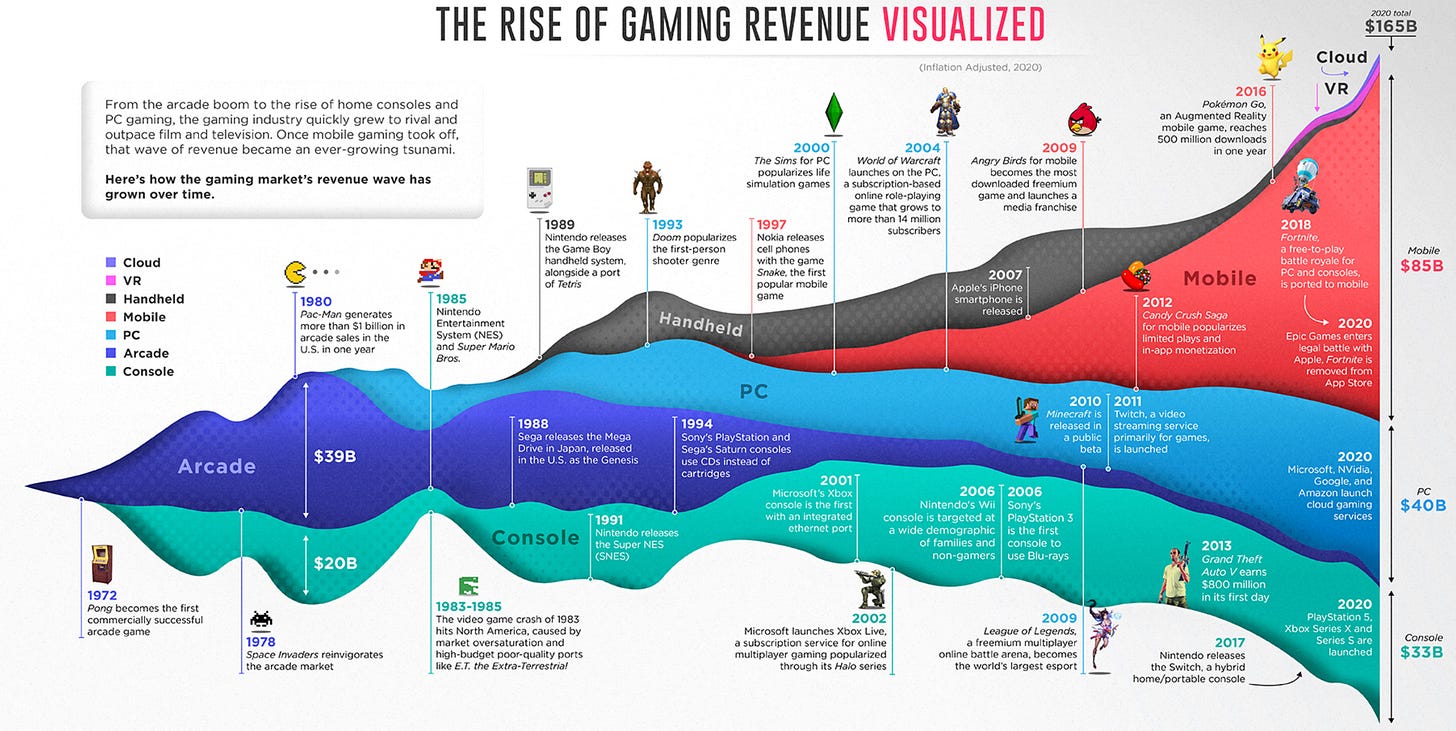From Pixels to Profits: Decoding the Video Games Industry
Perspectives and stock analysis
As a gamer myself, I can only welcome the expansion of the videogame market. Combining creation, technology and media franchise management, the sector is exciting and constantly evolving.
Beyond recreation, video games have become a cultural phenomenon, a means of conveying messages and a recognized form of artistic expression. It has established itself as a huge industry.
In this article, we will present the video game market. We will summarize various studies to estimate the size of the market and its major trends. After that, we will identify stocks and use our rating system to identify the best ones. This will include a fair price estimation to see which stocks are undervalued, fairly valued or overvalued.
Quick overview
The video game market is a dynamic and multifaceted industry, continually evolving to meet the demands. As technology advances and consumer preferences shift, the industry develops new business models and new entertainment modes.
In the process of creating a video game, various key actors play distinct roles, each contributing to different aspects of the development, marketing, distribution, and sales. Here's an overview of the roles of the main actors involved in the video game industry:
Editor. The game editor oversees the creative and technical aspects of the game development process. They ensure that the game aligns with the intended vision, meets quality standards, and is on schedule.
Publisher. Publishers are responsible for financing, marketing, and distributing the game. They act as intermediaries between developers and consumers, facilitating the process of bringing the game to the market.
Retailer. Retailers are entities that sell the physical or digital copies of the game directly to consumers. They can be brick-and-mortar stores, online marketplaces, or a combination of both.
Initially driven by arcade games, the market has gradually moved towards PC games and home consoles. Mobile games then appeared. New gaming media are now appearing with the cloud and VR. Free-to-play is a growing business model, transforming sales-only revenues into more continuous in-game revenues. It is particularly strong in mobile games.
Initially very male-dominated, the players are now fairly evenly distributed, with 52% men and 48% women.
Asia is the main market in the video game industry with around 50% of the total market share.
From AAA games costing hundreds of millions of dollars to independent productions, the market is very large and offers room for new entrants relatively easily. The rise of small studios, such as CD Projekt with The Witcher or Larian with Baldur's Gates, shows that it is possible to carve out a place among the giants with limited initial resources.
Market dynamics
The different trends in the video game market are as follows:
Mobile gaming. Mobile gaming represents more than 50% of the gaming market. This marketshare should continue to increase.
Digital distribution. The physical distribution currently represents less than 20% of all the games sold. The market share of digital distribution will continue to grow.
Growing online gaming and increase usage of social media. The increasing number of people who prefer to play video games online is developping the usage of Massive Multiplayer Online games (MMO), mobile videogames and Free-to-Play games (F2P). This trend is expected to continue over the next years.
New uses are developing, such as the use of video games in the medical field or education. It can contribute to help improve learning efficiency, heal disease, increase brain development or help for rehabilitation after an accident or illness.
Streaming and e-sport are also new uses, creating markets in their own right. They are growing rapidly, changing the way they are broadcast, promoted and consumed.
Introduction of new technologies, like Virtual Reality (VR), AI or blockchain, is also a new interesting trend.
Increasing regulation and legislation is creating instability as we saw recently with the very strict regulations imposed by the Chinese government. Protectionist measures can also be seen in the distribution of video games in different countries, such as China, once again.
Cloud gaming is a interesting new kind of distribution. It will allow to easily create a subscription model and to be less dependent on the hardware from the customer side.
E-sport
The e-sport is an interesting segment of the video games sector. The industry reached $1 billion revenue in 2020 with an audiance of more than 500 million people. The growth is currently around 15% per year.
E-sport has seen many newcomers since the COVID-19.
E-sport development is helped by the increasing use of streaming platform like Twitch from Amazon, with its huge market share.
Cloud gaming
Even if it only represents a small market segment for now, I am convinced that cloud gaming has great potential.
In fact, it offers 3 interesting advantages:
The first is that you don't have to depend on hardware on the customer's hardwares to be able to play
The second is the implementation of a subscription model, which is interesting both for the company and for the customer, who can multiply his game library
Finally, it limits friction in the gaming experience and facilitates distribution
The key of this market will be infrastructure to over a pleasant, low-latency gaming experience and the catalog which will have to be large enough to attract users. Several companies may emerge to propose this kind of new service, but size will be very important. Microsoft is particularly well positioned in this segment, with both the catalog and the cloud infrastructure.
Market size by 2030
Before looking at the 35 stocks of the stock screener and their fair value estimation, let’s take a look at the estimated market size by 2030 to identify the long-term growth potential.
Keep reading with a 7-day free trial
Subscribe to Quality Stocks to keep reading this post and get 7 days of free access to the full post archives.







